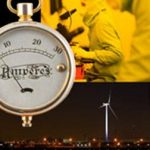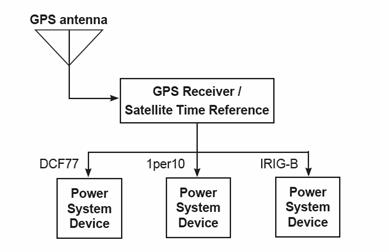GPS time Synchronization: Power system reliability starts with precision timing.
Precision timing is required for monitoring and control of electrical power networks where power system reliability is important. Circuit breaker control schemes require precise timing to ensure proper operation, and Sequence of Events Recording systems report events with one-millisecond precision to aid diagnostics and troubleshooting. Typical “critical power” applications include electric utility networks, data centres, hospitals, water treatment plants, refineries, and other process industries.
Global Positioning Systems can be used to provide a precise time reference for power system devices in an electrical network, ensuring time synchronization even across great distances. A generic GPS system architecture is shown below:
A GPS antenna receives a time signal from the system of satellites orbiting the Earth. A GPS receiver accepts raw time data from the antenna and converts it to one or more time protocols.
Each power system device accepts a sync pulse, usually via a dedicated, high-speed digital input. The device then sets its internal clock by decoding the supported time protocol. Several time protocols are available, each with its advantages:
- IRIG-B — time codes originally developed by the US military and widely used by electric utilities and others, especially in the United States. IRIG-B is typically distributed as a DC level shift (unmodulated IRIG-B) with 100 pulses per second. Examples of devices which implement IRIG-B include PowerLogic ION-8600 meters from Schneider Electric and SER-3200 event recorders from Cyber Sciences.
- DCF77 — standard time protocol well-suited to power applications because it requires less processor overhead than IRIG-B, yet offers equivalent accuracy. The 24Vdc pulse provides a complete date/time string once every minute. The DCF77 signal is broadcast from Germany and can be accessed from most of Europe via a dedicated DCF77 receiver. Alternatively, a GPS receiver can be used to accept a GPS signal, convert this to DCF77, and distribute the signal to multiple devices. Examples of devices which support DCF77 include PowerLogic series CM3000 and CM4000 meters, PM870 meters, and Quantum PLCs using an ERT module, by Schneider Electric. (More on DCF77)
- 1per10 — time synchronization protocol used by Sepam relays by Schneider Electric. One pulse every 10 seconds provides a precise time reference enabling Sepam relay clocks to maintain accurate time and date. In fact, an approximate date and time is provided to Sepam by some other means (e.g., supervisory software), and the GPS time-sync pulse is used to achieve higher accuracy. (More on 1per10)
Network Time Protocol is a web protocol used to provide a time reference over an Ethernet network or even the Internet. However, the accuracy that can be achieved with this approach is normally on the order of one second – not sufficient for the one-millisecond precision required in most critical power applications.
A relatively new standard for precision time synchronization is defined by the IEEE in standard IEEE-1588 (also known as “Precision Time Protocol” or PTP). Using the IEEE-1588 protocol, devices can achieve sub-millisecond accuracy over an Ethernet network. However, special Ethernet hardware is required, and the protocol is not yet widely available in electrical power devices. In the future, it is likely to be implemented widely in power system, in conjunction with GPS technology.
GPS time synchronization is especially useful when power system devices are located in different physical locations, such as several buildings in a campus arrangement or multiple substations separated by great distances. For more technical details on GPS system architectures and examples illustrating power system devices, please see this Technical Note .
Robert Kennedy
see also this related discussion on the forum


i dont know about this but it is good pls anyone give me its explainnation
Asslam o Alikum
Sir,
I am a student of Electronics from (Goverment College of Technology) in 3rd year i want training relate to electronics in your company pls give me apportunity.My email addres :masoodalampk4@yahoo.com
Thank you
Hi ,
Your blog is excellent and very informative to our visitors. Post was very nicely written and it contains useful facts. I am happy to find your distinguished way of writing the post.
I found your website perfect for my needs. It contains wonderful and helpful posts. I have read most of them and it was informative for all.
XXXXXXXXXX(Comment edited by moderator team)Really an interesting post.Doesn’t know about such thing in power system before.
yes.good idea in protection as well as energy efficiency programs.post more.
thanks
good post . help me with 12kv lightining arrester sectional diagram. thanks.
Your blog is excellent and very informative to me. I am happy.
I found your website some what perfect for my needs. It contains wonderful and helpful.
I want to get all free Industrial software & downloads .
I’m a 3rd year student from University of Malaya.this info is very useful for me but can you tell me m ore about this?I’m currently doing my internship and would like to propose this matter to my manager. but I need to do some research first.
Thanks for the information. I have one question (not sure if you’re the right person to ask):
GPS gives precision timing even with different receivers? I mean, if you have GPS receivers at different locations synchronizing Sepam times all the Sepams at the installation will share the same time with millisecond precision?
We would like to record from time to time some data from them with remote access (GRPS) and would like to have a synchronizing method that does not require establishing connection.
This is in reply to Ignacio Soler’s question of 15-June. Yes, you are exactly correct. If you have many GPS receivers in different locations, they all sync to the same satellite system, and so all Sepam relays synchronized to this system will share the same time reference to within 1 ms precision. This is true for Sepam (and other power system devices) in the same physical location or across the world in another time zone. They can all reference Universal Coordinated Time (UTC) with 1 ms resolution in time stamps.
For more technical information, please visit our web site at http://www.cyber-sciences.com or email us a question at sales@cyber-sciences.com. We would love to hear from you!
Hi
Current GPS technology are important branches, such as navigation and future goft the individual pursuit.
Hi Robert – the GPS technology has evolved into a more useful tool nowadays. It’s now a must feature in new gadgets that we have. Thanks for explaining the connection between GPS and precision timing. It’s really good to know this…
A lot has changed since I proposed this article 3 years ago. To see the latest information on GPS time sync of power system devices, especially for Sequence of Events Recording systems, please visit our web site:
http://www.cyber-sciences.com
We also publish technical notes on topics requested by our customers. I would be very interested to hear your questions or learn of your experiences. I look forward to hearing from you–in English, Francais or Español.
Best regards / Cordialement / Saludos